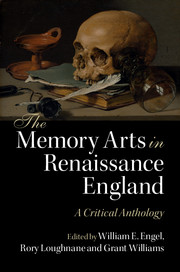Book contents
- Frontmatter
- Dedication
- Contents
- List of figures
- Acknowledgements
- A note on abbreviations
- Introduction
- PART I The art of memory
- PART II Rhetoric and poetics
- PART III Education and science
- PART IV History and philosophy
- PART V Religion and devotion
- Introduction to Part V
- V.1 Thomas More, A Treatise (Unfinished) upon these Words of Holy Scripture (1522)
- V.2 John Foxe, Acts and Monuments (1563)
- V.3 Thomas Playfere, The Pathway to Perfection (1593)
- V.4 Joseph Hall, selected works
- V.5 Richard Day, A Book of Christian Prayers (1608)
- V.6 Daniel Featley, ‘Four Rows of Precious Stones’ (1610)
- V.7 Lewis Bayly, The Practice of Piety (1613)
- V.8 John Donne, ‘Sermon, preached at Lincoln's Inn’ (1649)
- V.9 Stephen Jerome, A Minister's Mite (1650)
- V.10 E.M., Ashrea (1665)
- PART VI Literature
- Index
Introduction to Part V
from PART V - Religion and devotion
Published online by Cambridge University Press: 05 August 2016
- Frontmatter
- Dedication
- Contents
- List of figures
- Acknowledgements
- A note on abbreviations
- Introduction
- PART I The art of memory
- PART II Rhetoric and poetics
- PART III Education and science
- PART IV History and philosophy
- PART V Religion and devotion
- Introduction to Part V
- V.1 Thomas More, A Treatise (Unfinished) upon these Words of Holy Scripture (1522)
- V.2 John Foxe, Acts and Monuments (1563)
- V.3 Thomas Playfere, The Pathway to Perfection (1593)
- V.4 Joseph Hall, selected works
- V.5 Richard Day, A Book of Christian Prayers (1608)
- V.6 Daniel Featley, ‘Four Rows of Precious Stones’ (1610)
- V.7 Lewis Bayly, The Practice of Piety (1613)
- V.8 John Donne, ‘Sermon, preached at Lincoln's Inn’ (1649)
- V.9 Stephen Jerome, A Minister's Mite (1650)
- V.10 E.M., Ashrea (1665)
- PART VI Literature
- Index
Summary
What passed as conformist writings and devotional practices in one decade may well have been deemed heretical or at least suspect in another. Within a thirty-year span, England converted three times: from a Catholic to a Protestant nation under Henry VIII and refined further under his son, Edward VI, with the Book of Common Prayer; back to the Church of Rome under Mary and the harrying of those resistant or reluctant to conform, as later memorialised by John Foxe (V.2); and once more to a re-establishment of the Reformed church under Queen Elizabeth. It is no wonder then that her successor, James I, convened a conference at Hampton Court to consider the condition of the Church with the hope of settling peacefully religious issues and grievances, out of which would emerge an ‘authorised’ version of the Bible in English that still bears his name.
Among the consequences precipitated by the initial break with Rome and subsequent suppression and dissolution of monasteries were the demolishing of religious shrines, the dispersion of saints’ relics, the breaking up of libraries and a brisk trade in devotional objects. New modes of prayer, ceremony and worship were required, especially to meet the social and spiritual needs created by the abolition of chantries, the endowments set up to celebrate masses and say prayers for the souls of deceased founders and others in the community. As a result funerary rites and burial ceremonies shifted considerably. Such measures paralleled the frequently contested developments in the reordering of the Church, including the refounding and reconfiguration of important social institutions such as charities, schools and hospitals. During this time of rapid if uneven transition, it is understandable that memories of the past frequently were accompanied by a lingering sense of loss, exemplified by among others Fuller (IV.7) and Dugdale (IV.10); and sometimes expressed in ways that recalled the tone of plague tracts, such as John Dekker's The Wonderful Year (1603) and George Wither's Britain's Remembrancer (1628), as well as consolatory funeral elegies like those by Quarles (VI. 7) and Holland (VI. 5).
Far from being instantaneous or ubiquitous, conformity and conversion were recognised as ongoing processes – for individuals as well as communities, let alone the nation. And so while it was acknowledged that religious change could lead to salvation, it was also associated with deceit and treachery.
- Type
- Chapter
- Information
- The Memory Arts in Renaissance EnglandA Critical Anthology, pp. 227 - 232Publisher: Cambridge University PressPrint publication year: 2016



